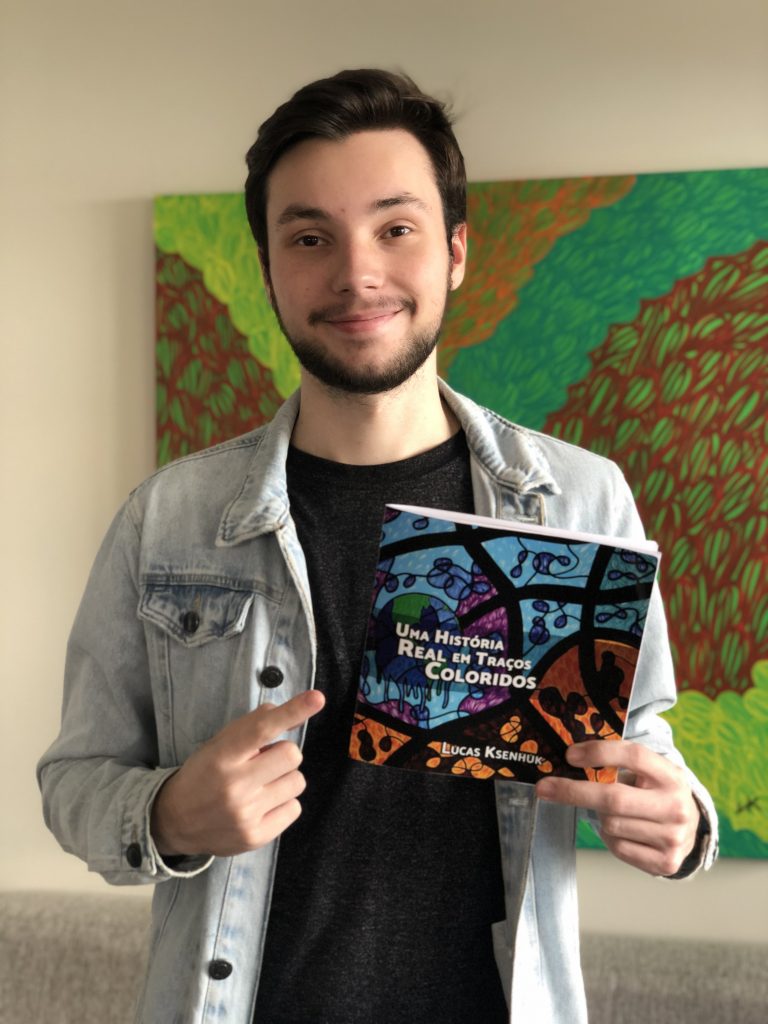
Lucas Ksenhuk is an 18-year-old Autistic artist from Brazil. He has an unmistakable style that has been the talk of many street art exhibitions in São Paulo, such as Egg Parade, Cow Parade, and Elephant Parade, Football Parade, Ear Parade, and Vitruvian Parade. Lucas believes his art can help people and sees it as a way to transform his own life and that of others, bringing independence and recognition to the spectrum. Lucas’ recently released book with Underline Publishing, A Real Story Created With Colorful Lines, tells his story of a young autistic man who overcame his difficulties through art and is illustrated with images of his work. He discusses his life experience being autistic and how he became a recognized visual artist.
When/how did you become aware of your Autistic identity?
I started to become aware of my autism at the end of my infancy. When I felt overwhelmed without the ability to communicate properly, especially in school. I felt that there was something wrong inside of me. Thus my mother, along with her friend and a therapist Eric Hamblen, explained to me the concepts of autism and how it had affected me.
Assess autism acceptance in your community. Where/how are people accepting and supporting people on the spectrum? Where does society need to improve?
From a scale of 0 to 10, I believe it is around 5.
Some negative aspects are that people don’t take these feelings of people with autism too seriously– some people use the term “autistic” as if it’s addressing a defect in someone. I notice these people don’t understand what autism is, and additionally, are unwilling to learn.
On the other hand, there is a great movement toward the ideology of consent. There are people working seriously for this right. They are doing whatever it takes for the inclusion of people with autism.
I believe our communities should improve in the sense of understanding every “autistic” person, is in fact a person and not an object. Furthermore, each one of us are unique despite having the same diagnosis. The stereotypical generalized saying of “Every autistic is…” cannot influence the true issue. Therefore, every individual with autism should receive what they need, from our communities, and supported by public policies. Consequently, I believe it’s necessary to have empathy towards the family of someone with autism, such as balancing the enjoyment between the whole family together. These moments can bring relief and the opportunity of maturing for all. If everyone does a little bit, the result will be big.
Have you ever heard/seen someone advocating for an individual on the spectrum, but what they were saying or doing was unintentionally unhelpful? Another way of asking this might be what well-intentioned mistakes might parents or educators make when trying to support someone on the spectrum?
A common mistake is the underestimation of potential of a being with autism. Even if they are severe in this spectrum, they can feel the sense of self worth. I know people with autism go on to learn impressive things. Another common mistake is to talk way too much when a kid with autism is in a moment of confusion. It worries me, because when I look at a kid with autism going through a struggle, I think of ways to protect them. During these times, over talking only makes them insecure and even more confused.

What inspired you to write A story created with colorful lines? Who is the main audience? What do you hope readers gain from reading it?
Both my mother and father inspired and supported me. They have always been with me during all moments, even at challenging times. They were always there for me. I also want to talk about my past for kids who go through bullying, and want them to know that it is possible to overcome the struggles.
The book is directed to children, pre teens and teens. But I also recommend it for adults. Everyone can read and learn about my history and try to relate with similar experiences. I believe the moral of the story is to persevere, use whatever is available in reach, and not to give up on your dreams.
Where do you find inspiration for your art? What is your work process and/or creative process like?
My inspiration comes from colors. I enjoy placing colors and giving them a movement through the canvas. So a lot of things I see are thought out on how it would go together with my patterns. From there, I sketch out on a separate paper to have a better idea of the piece I’m making. Once I’m happy with the sketch, I recreate it on a canvas or an object.
In what ways have the people around you encouraged your development as an artist?
I believe that as long as people are interested in my art, motivation comes in naturally. Such as compliments, job opportunities for my work or even sharing about my artwork to others.
Is your artwork currently on display anywhere or available for sale?
Unfortunately, in this current pandemic it’s not possible to have a presential show. But I am planning out a virtual gallery. My work can also be seen and purchased though my instagram @lucasksenhuk, my facebook Lucas Ksenhuk, or in www.lucasksenhuk.com
Do you have any advice for aspiring Autistic artists?
Believe in your identity as an artist and on the work you make. Be consistent and practice a lot. We aren’t failures, and we need to show our worth and talent to the world!
